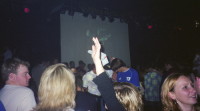 Photo.
Photo. The party
is going on in Lucerna Music Bar, Prague.
Absinth - the drink which give you the extra kick
Absinth
is a mysterious Chech drink which gives you the real kick. It's liquor, usually
green in colour and hence received the name "The Green Fairy". If you can
stand it, you would get in the best party mood. Absinth is probably the world's
strongest legal drink.
According to the website AllPraha.com, it was discovered by
doctors and used mainly as a military medicine early on. It contains a
psychoactive neurotoxin called thujone, made from wormwoord, an herb. In the
United States and many other countries it is illegal, but in the Czech Republic
it is legal.
|
Photo. The Czech Devil. For us this devil
brought good luck and happiness on the tour.
I wouldn't say it tasted good. Drinking Absinth can give you a mix
feeling of occultism, flame "swallowing", and taking strong medicine.
In many cases Absinth has an anise/black liquorice flavour and has been
compared to everything from ""pure perfection"" to ""mouthwash gone bad."
|
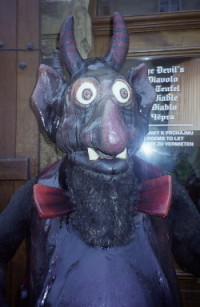 |
There are many ways to drink it. Inspired by the Czech tradition we filled
our glasses up with absinth. Then we stirred the drink, and so we dipped a spoon
filled with sugar in the glass. Further we lighted up the spoon with fire,
letting the sugar melt (caramelize), and so we turned the melted sugar into the
drink and stir. We were almost spell burned by the flames.
Since we are Vikings and used to strong drinks in Norway, we added no water
into our glasses. Immediately the fluid in the glasses started to burn. The
flames rose up. I hoped that the fire brigade where close to us, but there was
nothing to worry about.
| Photo. Two Norwegian partylions, Oddvar and
Sigurd ("Sugar") drank plenty of cold Czech beer to stop the
"fire" in their throat. |
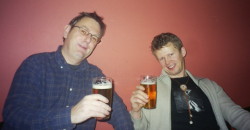 |
Since we are not flame eaters, we blow out the
flames after a short while. Few seconds later the fluid cooled down, and so we
swallowed the drink straight down. It felt like our throats were burning up, and
we desperately ordered some glasses of beer to flush it down - both for washing
and cleaning the throats. It also made us feel little bit intoxicated, but so
far everything was under control. Videofilm of
the hard and happy drinking sequence will be available
soon!
|
Photo: Plzenský Prazdroj - Pilsner Urquell - Czech
Beer.
Pilsener beer was used to wash and clean our throats after drinking the
strong Czech drink Absinth (Absinthe).
Prague Breweries is the real place to enjoy Czech beer! |
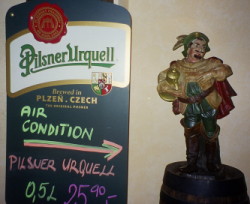 |
You can have absinthe at almost any bar in Prague. You can buy it everywhere
here, including street vendors. Some famous brands are Hill's Absinthe,
Staroplzenecky Absinthe, Absinthe King of Spirits, Red Absinthe (Red in colour),
Absinthe Original, and La Fee Absinthe. The main traditions of manufacturing are
according to French or Swiss recipes. So far I know is the Czech spelling of
absinthe "absinth", leaving off the "e", but how they Czech pronouce it
after 3 - 4 glasses of the drink could vary.
From Velvet revolution to Party revolution
While the Iron
Curtain was still in place, Prague was seldom visited by westerners. Since the
1990s all this has changed. Prague is now one of the most popular tourist
destinations in Europe, and the people there are enjoying the highest economic
boom since the 1920s.
Things started to happen for 15 years ago. People demanded freedom. The
Prague Post (17 November 2004) interviewed several Czech citizens about whether
they were surprised, disappointed or elated with how the country has changed
over the last 15 year, and how well they think Checks have come to terms with
their country's communist past. There is only one conclusion on that: Czech has
coming out of the cold.
Czeck people are really nice and warm hearted. They like contact with people
from Western Europe and they like partying. The diversity of the party life is
fantastic, from clubs, pubs, bars, discothèques and concerts.
|
Photo. Stein Morten and Oddvar accompany the Santa
Claus Devil. See the horns on the hat.
It`s soon Christmas, so what can we expect this time? Was this the Devil
disguised as Santa Claus or was it just the real Santa Claus with a
new image? |
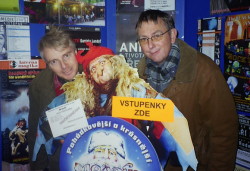 |
Prague's beautiful architecture has survived six hundred years from
natural disaster and wars. How long wills the city retains its architecture if
the party life continues to grow? Be ready for a long night in Prague and
dancing the night away!
Stein Morten Lund, 28 December 2004
Additional information
Lucerna Music Bar
Prague 1,
Vodičkova 36,
Tel: 24 21 71 08
Club open 6 pm-3 am.
Café open daily 11
am - 5 pm
Beginning of concerts at 9 pm
Website: www.musicbar.cz
More information about Absinthe (click on the link): Absinthe
information.
Highlights in Prague for they who
want something else than just partying:
Prague Castle: Has been a symbol
of Czech history for centuries. After 894 it became the main seat of the oldest
ruling dynasty of the state Bohemia, the Premyslid princes (Premyslovci).
St.Vitus Cathedral: The largest and the most important church in
Prague. The religious heart of the Czech Republic.
Charles
Bridge: Prague's most well-known monument. The oldest stone bridge in
Central Europe with many expressive Baroque statues made by sculptors Braun,
Brokoff and Kohl. The bridge is colorful with a variety of vendors (of woodwork,
jewelry, and paintings), street musicians and puppeteers.
Old Town
Square: The oldest and most important square in historic Prague dating from
the 12th century. Make sure that you visit the Astronomical Clock (Orloj), built
in 1410, and watch the mechanical performance by 12 Apostoles.
Jewish
Prague: Places of interest are the Town Hall, five synagogues (Old-Town,
Pinkas, High, Klausen, Maisel) and Old Jewish Cemetry.
Emausy Monastery --
The monastery and the church is very richly decorated. The cycle of Gothic wall
paintings dating from 1360-1370 is one of the most valuable relics of that time
in Bohemia.
Petrin Outlook Tower: Petrin Park is one of Prague's
largest parks. The most conspicuous landmark in this park is an imitation Eiffel
Tower, built for the Jubilee Exhibition of 1891.
St.Nicholas
Temple: The most significant historical structure of the Prague Baroque.
Modern history of Prague:
After the independence and
foundation of the Czechoslovak Republic, Dr. Tomas Garrique Masaryk become the
first Czech President.
1920 The National Assembly carried the first Constitution
1938 Mnichov
agreement - Czech had to renounce Soudets
1939 Started Second World War,
Prague - capital of Nazi Protectorate Bohemia and Moravia
1945 Liberation by
the American and Soviet army, Dr. Edvard Benes - president
1948 The February
putsch seizure power of KSC
1960 Foundation of the Czechoslovak socialistic
republic
1968 Prague Spring - an attempt to reform socialism, intervention
of 5 states of the Warsaw Pact
1989 Velvet revolution, formation of the
government of national tolerance, Vaclav Havel become elected as the
president
Information resources about Prague:
www.praguetourist.com
www.Frommers.com
www.Travelofix.com
www.Fodors.com
www.InyourPocket.com
Facts about the Czech:
Formal country name: Czech
Republic
Area: 78,866 sq km
Population: 10.3 million
Capital City:
Prague (population 1.2 million)
People: Czech with minorities of Slovaks,
Poles, Germans, Romanies and Hungarians
Language: Czech
Religion: 40%
Roman Catholic, 10% Protestant
Government: parliamentary
democracy
CzechTourism Official travel site of Czech Republic:
www.czechtourism.com.
